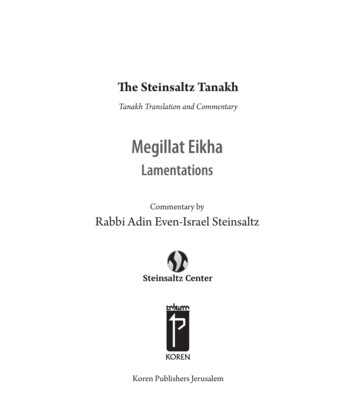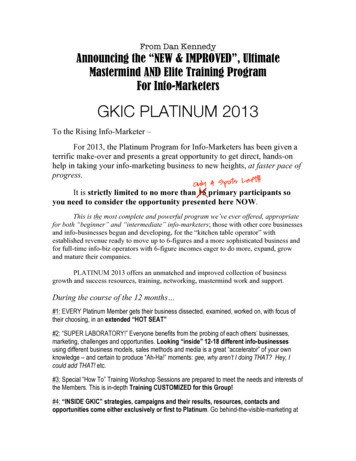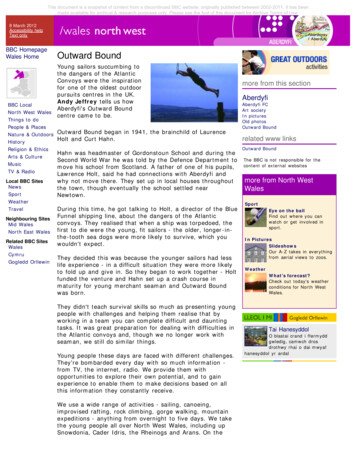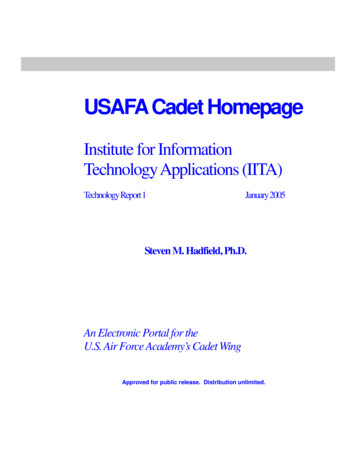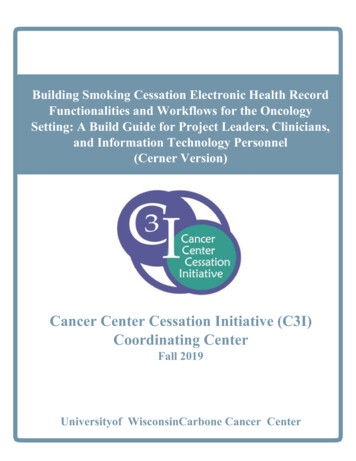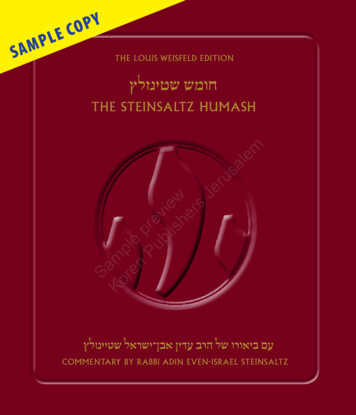
Transcription
THE LOUIS WEISFELD EDITION חומש שטינזלץ rusalemTHE STEINSALTZ HUMASHSaKo mre plenPu prebl vieis whersJeLPMSAYPOEC עם ביאורו של הרב עדין אבן־ישראל שטיינזלץ COMMENTARY BY RABBI ADIN EVEN - ISRAEL STEINSALTZ
The Steinsaltz HumashHumash Translation and CommentarylemCommentary bySaKo mre plenPu prebl vieis whersJerusaRabbi Adin Even-Israel SteinsaltzKoren Publishers Jerusalem
Executive Director, Steinsaltz CenterEditor in ChiefRabbi Meni Even-IsraelRabbi Jason RappoportExecutive EditorsCopy EditorsRabbi Joshua SchreierRabbi Dr. Joshua AmaruCaryn Meltz, ManagerAliza Israel, ConsultantIta Olesker, Senior Copy EditorDebbie Ismailoff, Senior Proofreaderand Language ConsultantChava BoylanSuri BrandIlana BrownCarolyn Budow Ben-DavidRachelle EmanuelShira FinsonCharmaine GruberDeborah Meghnagi BaileyDeena NatafDvora RheinElisheva RufferIlana SobelsaruSaKo mre plenPu prebl vieis whersJeRabbi Ayal Geffon, Senior Content EditorRabbi Yedidya Naveh, Senior EditorRabbi Michael Siev, Senior EditorRabbi Avi Grossman, Senior EditorRabbi Aryeh Sklar, Content CuratorRabbi Alan HaberYisrael KalkerElisha LoewensternRabbi Eli OzarowskiAvi SteinhartRabbi David StrausslemEditorsHebrew Edition EditorsSara Friedland Ben ArzaRabbi Yossi Ben ArzaRabbi Meir KleinRabbi Daniel EliavTechnical StaffTani BednarshAdena FrazerShaltiel ShmidmanDesign & TypesettingAvishai Magence, Production ManagerEliyahu Misgav, Art DirectorBentzi Binder, Design &TypesettingEstie Dishon, TypesettingLanguage ExpertsDr. Stéphanie E. Binder, Greek & LatinRabbi Yaakov Hoffman, ArabicShira Shmidman, Aramaic
Introduction to the Steinsaltz HumashScholars and lay readers alike are aware that writing a new commentary on the Bible requires assistance and blessings from Above,as well as substantial effort from below. Two fundamental challenges stand before one who seeks to write a commentary on theTorah: First, the aspiration to relate to the loftiest and holiest text and to explain it faithfully risks hubris. Second, a huge numberof commentaries on the Bible have been composed over the course of the past three thousand years by the greatest people in ourhistory. Who has the audacity to attempt to join this holy assembly or even grasp its coattails?Sanction for undertaking this daunting task can be found in Rashi’s statement to his grandson Rashbam, himself the authorof an important commentary on the Torah. Rashbam reports Rashi to have said that if he had had the strength, he would havewritten another commentary in accordance with the “plain meanings that are renewed every day” (Rashbam, Genesis ƧƬ:Ʀ).rusalemIn every generation and on each passing day, fresh light can be shed on the verses of the Bible and new perspectives can befound. Not only are new answers offered to old questions, but in every era additional questions are raised by students of the Bible,due to both the diversity of the personalities, and the differing interests and perspectives, of each era. Throughout the ages, thegreat commentaries have discussed a wide range of different issues. To this day, thank God, there are many scholars and studentsof the Bible raising unique questions and challenges that require attention, analysis, and investigation. All these illuminate theeternal words of the Torah through a range of viewpoints and give rise to “plain meanings that are renewed every day.”SaKo mre plenPu prebl vieis whersJeThis commentary seeks to offer the reader the plain meaning of the text, the peshat. Ostensibly, this is the simplest level ofinterpretation, but the elucidation of the plain meaning is actually the most difficult type of interpretation. Other kinds ofinterpretation, based on allusion [remez], midrashic hermeneutics [derash], or esoteric, mystical traditions [sod] are free to forgelinks between the text and the sources from which they draw and are not constrained by the language and concepts of the Bible.In contrast, discovering the plain meaning of the text requires the interpreter to adhere closely to the literal meaning of thewords while paying attention to syntax and context. The best way to go about this has always been a matter of debate, and theelucidation of the plain meaning of the Torah as a holistic entity will never be fully achieved (see, e.g., Ibn Ezra’s introduction tohis commentary on the Torah).Finally, there is a fundamental problem that is unique to interpretation of the Torah: The aim of finding the plain meaningis related to the author’s intent, yet the infinite consciousness of the Giver of the Torah is unfathomable and boundless (seeRamban’s introduction to the Torah).Although this commentary includes references to many other commentaries, it is not an anthology. It was not intended toprovide a comprehensive array of interpretations from across the generations. The aim of the references is to show that a suggestedinterpretation is based on earlier sources or discusses a similar question. Moreover, this work does not aspire to be revolutionaryor novel. Rather, it aims to present what might be called a “transparent” commentary, one whose explanations should go almostunnoticed and serve only to give the reader and student the sense that there is no barrier between him or her and the text. Theaim is to let the Torah speak for itself, to allow the prophets to prophesy and the wise men to impart their wisdom. In order toenable the “voice” of the verses to be heard, the annotations are brief, serving as a thin, barely perceptible screen rather than aheavy, concealing coat of armor.At Mount Sinai, the entire Jewish people heard “a great voice” (Deuteronomy Ʃ:ƥƬ), which the Sages interpret to mean a voicethat has never ceased (Targum Onkelos; Sanhedrin ƥƫa). It is my hope that this project will help people hear the voice of the Toraheven in our busy, noisy world.Rabbi Adin Even-Israel Steinsaltzix
Book of Genesis Chapter 1 BereshitParashatBrief summary of themes in the narrativeBereshitExplanatory notes clarify the text andinclude a vast amount of rabbinical andcontemporary sourcesIt is commonly thought that the beginning of the book of Genesis presents a cosmogony, a theoryof how the universe came to exist. While this is mostly correct, the account of Creation appearingGENESIS 1:1 2:3in Genesis diverges from other recorded accounts in that it disregards the question of what was thestarting point of existence itself. For this reason, the Torah begins the account of Creation with theword bereshit, which literally means “in the beginning of.” The account begins at the beginning ofsome preexisting process. Had the verse stated bareshit, it would have been understood as meaning simply “in the beginning.” By contrast, the termbereshit indicates the beginning of some specific, unnamed process. It appears that a fundamental message lies hidden in this first word: At some earlystage in the mysterious process of creating existence, God created the heavens and the earth.The Seven Days of Creationsalem3 The process of Creation begins: God said: Let there be light,and there was light.D It is difficult to understand the meaningor significance of the phrase “God said.” The most that can beunderstood from this cryptic description is that God transmitted a kind of message that there should be light, and His instruction came to pass. Light was the first creation to emergefrom tohu vavohu. It was unlike any form of light known to mankind; it did not emanate from a prior source. Perhaps it was noteven a physical light, but a unique phenomenon.4 God saw the light that it was good.D As soon as the lightemerged from the unformed universe, God evaluated it anddistinguished between good and bad. And God divided between the light and the darkness. Once light was created anddiscerned as good, the next phase of its creation began, namely,the stage of separation, which established the light as a clearlydefined entity. The act of discerning and separating betweengood and bad would continue till the end of time and manifestitself also in human history and civilization.5 God called the light day. From the inception of the conceptsof light and day, there was some measure of synonymy betweenthem. Nevertheless, they are clearly and independently defined.Aside from day’s association with daylight, the day denotesa specific period of time. At this early stage of the Creation,with the formation of light comes the establishment of time.Until this point, the universe was in a raw state, completelyunstructured and undefined; even space and time were not yetdefined. These concepts came into being when God willed it.And to the darkness He called night. Darkness as well is removed from its previous status as a description of space aloneand placed in a framework of time. The concepts of day andnight as they appear in this verse express what the Sages calledthe order of time, in other words, the notions of before andafter, relative concepts that did not apply when the earth wasru1 In the beginning, God created the heavens and the earth.The opening verse takes the existence of God as a given. It doesnot address questions about God’s origin or nature; rather,God is understood to be the absolute existence from whicheverything begins. Already at the beginning of the account ofCreation, heaven and earth appear as distinct entities and asa framework for all of creation, as detailed in the rest of thechapter.2 The earth was unformed and emptyD [tohu vavohu]. Theearth was completely lacking any structure or order. The heavens too were unformed and empty, but the verse initially focuses on the earth, its structure and content. Although thesetwo terms appear together in other places in the Bible, theprecise meaning of the word vohu is difficult to ascertain; it iseven uncertain whether vohu refers to a distinct concept. Anddarkness was upon the face of the deep. The deep may refer to deep waters, or to the unstructured universe, that existedat the time. At this early stage of Creation, nothing had yet toreceive definite shape; nothing had been revealed. Therefore,the darkness upon the face of the deep was merely the absenceof the light that was about to be created. Some commentariesmaintain that the darkness was not the absence of light, but anentity in itself, based on the verse “I form the light, and createdarkness.” And the spirit of God hovered over the surface ofthe water. Water is the first actual substance mentioned in theTorah, as the heaven and the earth are not substances but general entities or zones. The verse does not discuss the creationof the primeval substance that served as the foundation for allof existence. In any case, the Torah indicates that God’s power,or will, exists in some form in this reality. God is not locatedwithin these entities, and He certainly is not to be identifiedwith them; rather, He hovers close by while remaining separatefrom them.SaKo mre plenPu prebl vieis whersJe1Bold text refers to direct translation while the regulartext offers a fuller understanding of the narrative6
ספר בראשית פרק א בראשית Clear Koren Tanakh font פרשת בראשית א א ב ג ד ה אשית ָּב ָ ֣רא ֱאל ִ ֹ֑הים ֵ ֥את ַה ׁ ּ ָש ַ ֖מיִ ם ו ֥ ֵ את ָה ָ ֽא ֶרץ׃ ו ָ ה ָ ֗א ֶרץ ָהֽי ֥ ָ תה ֙תֹה ּ ו וָ ֔בֹה ּו ו ֖ ח ׁ ֶֹשך א ּ ב ֵר ׁ ִ ֖ י־אוֹר ֹאמר ֱאל ִ ֹ֖הים י ִ ה ֑ ל־פנֵ ֥י ַה ָּ ֽמיִ ם׃ וַ יּ֥ ֶ ל־פנֵ ֣י ת ֑הוֹם ו ֣ רו ּ ח ֱאל ִֹ֔הים מ ַר ֶח֖פֶ ת ַﬠ ּ ַﬠ ּ Digitalized, clear Rashi font י־טוֹב וַ יַּבדֵּ ֣ ל ֱאל ִֹ֔הים ֵּב֥ין ָה ֖אוֹר ו ֵּב֥ין ַה ֽח ׁ ֶֹשך ׃ ת־ה ֖אוֹר ִּכ ֑ י־אוֹר׃ וַ ַ ֧יּ רא ֱאל ִ ֹ֛הים ֶא ָ וַ ֽי ִ ה ֽ with vowels and punctuation י־ב ֶֹקר י֥וֹם ֶא ָ ֽחד׃ י־ﬠ ֶרב וַ ֽי ִ ה ֖ וַ יִּ ק ָ ֨רא ֱאל ִֹה֤ים ׀ ָלאוֹ ר י֔וֹם ו ַ ל ֖ח ׁ ֶֹש ך ָ ֣ק ָרא ָל ָ ֑י לה וַ ֽי ִ ה ֶ ֥ le m פרק א שי ּ ְ דגָ ְ ךָ ” )דברים יח , ד( ַ . ף ָּכאן ַ ָ ּ תה ”ר ׁ ִ )בר שי י , י( ֵ , אוֹמר ּ ְ : שי ּ ְ ברֹ ,’ שי ּ ָ ב ָר ֱ ל ִֹ ים״ וְגוֹ׳ ְּכמוֹ ’ּ ְ : ב ֵר ׁ ִ ”ב ֵר ׁ ִ ֵ לוֹמר ּ ְ ִ ח ּלַת ִ ּדבּ וּרוֹ הוֹש ַע” ְּ , כ ַ ” ִ ח ּלַת ִ ּד ֶ ּבר ה׳ ְ ּב ׁ ֵ ְדוֹמה לוֹ ְ ּ : ו ֶ הוֹש ע״ וְגוֹ׳ ֹ מר ה׳ ֶ ל ׁ ֵ הוֹש ע ַ ” , ויּ ֶ דוֹש ָ ּברוּךְ הוּא ְ ּב ׁ ֵ ׁ ֶשל ַה ָּק ׁ ֹאמר ְ , וֹרוֹת ָ ּבא ׁ ֶש ֵא ּלוּ ּ ְ ִ ח ּ ָל ִ נ ְב ְר וּ , )הושע , ב( . ו ְִאם ּ ַ שי ַ ה ּכֹל ָ ּב ָר ּ ֵ לוּ’ ְ , ו ׁיֵש ְ ךָ ִמ ְק ָר וֹת רוּשוֹ ’ּ ְ : ב ֵר ׁ ִ ֵ וּפ ׁ ”כי ל ֹא ָסגַ ר וּמ ַמ ֲע ִטים ּ ֵ ָ בה ַ ַ ח ְּ , כמוֹ ִּ : ׁ ֶש ּ ְמ ַק ְ ּצ ִרים לְ ׁש ָוֹנם ְ ”יִשא וּכמוֹ ׂ ָּ : ְ תי ִב ְט ִ י” ) יוב ג , י( ְול ֹא ּ ֵפ ַר ׁש ִמי ַה ּסוֹגֵ ר ְ , ַ ּד ֵ וּכמוֹ : יִש ֶאנּוּ ְ , ֶאת ֵחיל ַ ּד ּ ֶמ ֶ ׂשק” )ישעיה ח , ד( ְול ֹא ּ ֵפ ַר ׁש ִמי ָּ ׂ רוֹש ִ ” ם יַ ֲח ׁ רוֹש ַ ּב ְ ּב ָק ִרים” )עמוס ו , יב( ְול ֹא ּ ֵפ ַר ׁש ִ’ ם יַ ֲח ׁ שי ֲ ַ ח ִרי ) ” ישעיה מו , ”מ ּגִיד ֵמ ֵר ׁ ִ וּכמוֹ ַ : ָא ָדם ַ ּב ְ ּב ָק ִרים’ ְ , שי ּ ָ ד ָבר ַ ֲ ח ִרי ּ ָ ד ָבר’ — ִ ם ֵּכן י( ְול ֹא ּ ֵפ ַר ׁש ַ’מ ּגִיד ֵמ ֵר ׁ ִ רוּח ּ ְ ַ מ ּה ַעל ַע ְצ ְמךָ ׁ ֶש ֲה ֵרי ַה ּ ַמיִ ם ָק ְדמוּ ֶ ׁ , ש ֲה ֵרי ְּכ ִתיב ְ ” : ו ֱא ִֹ ים ְמ ַר ֶח ֶפת ַעל ּ ְפ ֵ י ַה ּ ָמיִ ם” )ל לן פסוק ב( ַ , ו ֲע ַדיִ ן ל ֹא ִג ּ ָּל ַ ה ּ ִמ ְק ָר ּ ְ ב ִריַּ ַ ה ּ ַמיִ ם ָמ ַתי ָהיְ ָ ה , לָ ַמ ְד ּ ָ ֶ ׁ ש ָּק ְדמוּ וּמ ּ ַמיִ ם ִנ ְב ְר וּ ַ , ע ָּ כ ְר ֲחךָ ל ֹא ָ א ֶרץ ְ , ועוֹד ׁ ֶש ַה ּׁ ָש ַמיִ ם ֵמ ֵא ׁש ִ ָ ֵ ּ ִ מד ַה ּ ִמ ְק ָר ּ ְ ב ֵס ֶדר ַה ּ ֻמ ְק ָ ּד ִמים ו ְַה ּ ְמ ֻא ָח ִרים ְּכלוּם ָּ : ב ָרא ֱא ִֹ הים ְ . ו ֹ א ָ ַ מר ָ ּ’ב ָר ה׳’ ֶ ׁ , ש ַ ּב ּ ְ ִ ח ּ ָל ָ ע ּ ְ ָ ב ַמ ֲח ׁ ָש ָבה לִ ְברֹ תוֹ ְ ּב ִמ ַ ּד ַ ה ִ ּדין ְ , ו ָר ָ ה ׁ ֶש ֵאין ִמ ְ ַ קיֵּ ם , ו ְִה ְק ִ ּדים ִמ ַ ּד ַר ֲח ִמים ו ׁ ְִש ּ ְ ָ פ ּ לְ ִמ ַ ּד ַ ה ִ ּדין , ו ְַהיְ נוּ ִ ּד ְכ ִתיב ּ ְ : ”ביוֹם ֲﬠשׂ וֹת ה׳ ֱ ִֹ ים ֶ ֶ רץ ו ׁ ְָש ָמיִ ם” )ל לן ב , ד( : ב ׀ תֹה ּו וָ בֹהוּ ֹ ּ . הוּ לְ ׁשוֹן ּ ֵ ַ מ ּה ו ׁ ְִש ּ ָממוֹן ֶ
Introduction to the Steinsaltz Humash S cholars and lay readers alike are aware that writing a new commentary on the Bible requires assistance and blessings from Abo ve, as well as substantial effort from below. Two fundamental challenges stand before one who seeks to write a commentary on the Torah: First, the aspiration to relate to the loftiest and holi est text and to explain it faithfully .
